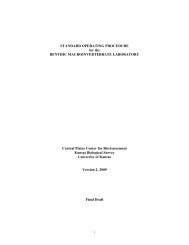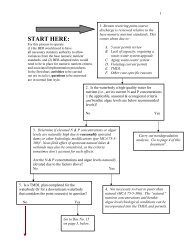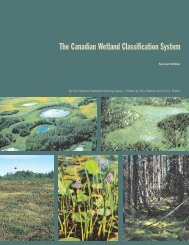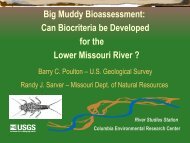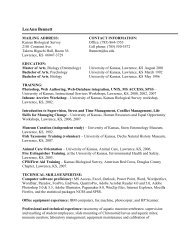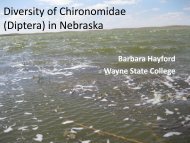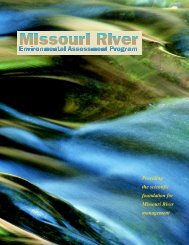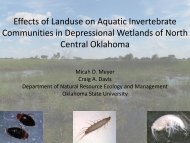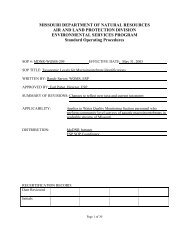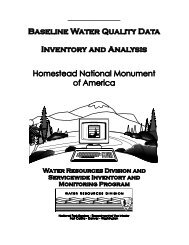Koontz, J., D.G. Huggins, C.C. Freeman, D.S. Baker - Central Plains ...
Koontz, J., D.G. Huggins, C.C. Freeman, D.S. Baker - Central Plains ...
Koontz, J., D.G. Huggins, C.C. Freeman, D.S. Baker - Central Plains ...
You also want an ePaper? Increase the reach of your titles
YUMPU automatically turns print PDFs into web optimized ePapers that Google loves.
major wetland classes when ANOVA and Tukey-Kramer tests were performed using wetland<br />
surface area as a factor. However, size significantly differed between lacustrine and both<br />
palustrine and riverine sites as indicated by Kruskal-Wallace non-parametric analysis and Z tests<br />
(p = 0.006). When area (acres) was placed in a Pearson correlation matrix, it was found to<br />
correlate positively with orthophosphate (PO4), total phosphorus, and atrazine concentrations<br />
with all relationships being significant (p = 0.05). When robust linear regression analysis was<br />
performed, the relationships between area and both PO4 and total phosphorus concentrations<br />
were not significant and adjusted R 2 values were essentially zero. The relationship between area<br />
and atrazine concentrations remained significant, but the amount of variance explained was small<br />
(p = 0.013, R 2 = 0.10). Further analysis and discussion of the atrazine concentrations of the<br />
wetland population will consider the significance of this relationship.<br />
Depth to Flood<br />
Depth to flood (DTF) was used as a surrogate for flood return period. The value of DTF was<br />
calculated using the KARS floodplain model and defined as the river height above river channel<br />
height needed to create a surface connection to the wetland either by backfill or sidespilling at<br />
the topographically lowest wetland boundary (Kastens 2008). Kruskal-Wallace non-parametric<br />
medians analysis revealed that the riverine class (n = 6) was significantly lower in depth to flood<br />
than lacustrine (n = 21) or palustrine (n = 32) classes (p = 0.043, regular Z variables significant).<br />
This should be expected given that riverine sites are either backwater channels or sloughs that<br />
become connected with the Missouri River channel at much more frequent intervals than sites<br />
more set back from the channel. ANOVA and Kruskal-Wallace tests revealed significant<br />
differences in DTF between the sample populations within the Western Corn Belt <strong>Plains</strong> and the<br />
<strong>Central</strong> Irregular <strong>Plains</strong>. The mean DTF value for the CIP wetlands was 7.81 while the WCB<br />
wetland population had a mean value of 3.71. The Interior River Valleys and Hills sample<br />
population (n = 5) had a mean DTF value of 4.72, which was not significantly different from<br />
either the WCB or CIP wetland population values. The fact that DTF values positively<br />
correlated with the linear distance from the Missouri River channel (R 2 = 0.91, p < 0.001)<br />
reflects the fact that floodplain valley widens and contracts along its lower portion and that sites<br />
within the CIP have greater distances of overland flow and significantly less connectivity with<br />
the floodplain (Figure 22).<br />
35 of 84



